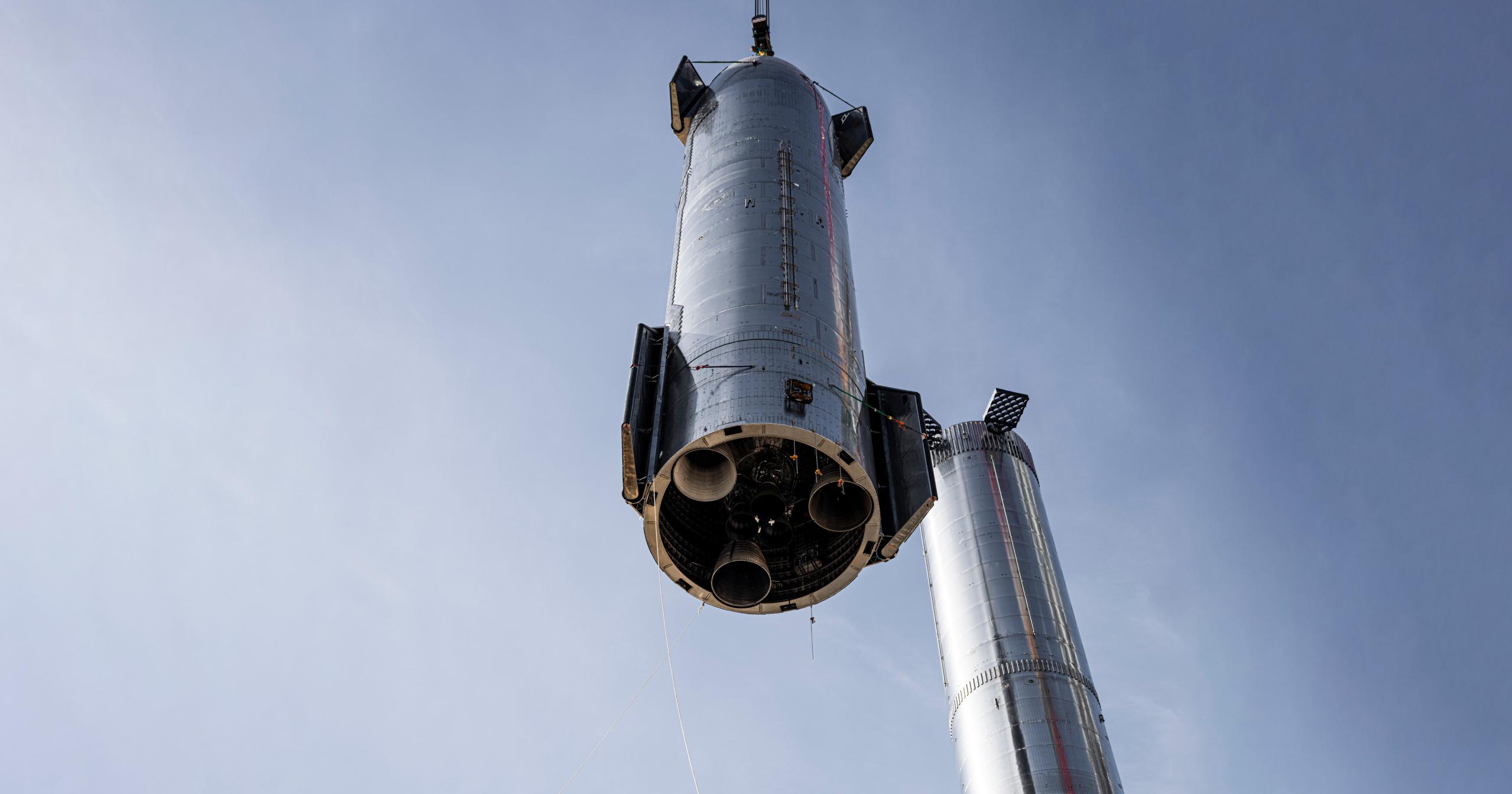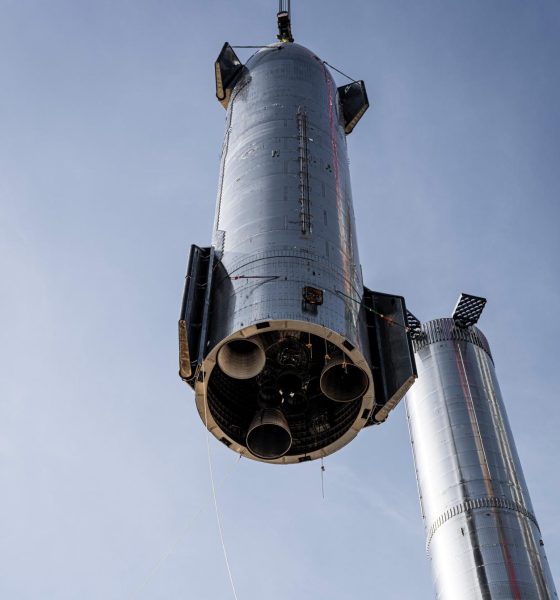

News
SpaceX to upgrade Starship with 50% more Raptor engines
SpaceX CEO Elon Musk says that future Starships – or at least certain Starship variants – are being upgraded with 50% more Raptor engines and stretched propellant tanks.
On December 17th, the CEO revealed the plans, confirming a tweet published three months prior stating that Starship was “begging for an extra 3 engines.” Musk was likely referring to the fact that a 9-engine Starship – combined with upcoming 33-engine Super Heavy boosters – would create a rocket with 42 engines, a number made famous as “the answer to the ultimate question of life [and everything]” in Hitchhiker’s Guide to the Galaxy – both of which the CEO vocally enjoys. As ever, it’s thus almost impossible to tell jokes from serious, consequential plans – as is the case with Starship.
Nonetheless, origination aside, adding another three Raptor engines to Starship – boosting the count from six to nine – and stretching its tanks could be a substantial upgrade.
According to amateur modelers, who are generally able to estimate rocket performance with enough information about its structures, shape, and engines; an optimal nine-engine Starship’s tanks would be stretched about 25% to store an additional 300 tons (650,000 lb) of cryogenic liquid oxygen and methane (LOx/LCH4). That upgraded Starship would have a liftoff mass close to 1600 tons (3.5M lb) and stand about 55 meters (~180 ft) tall – 10% taller than current ships.
At stage separation, close to vacuum, a stretched Starship with three sea-level-optimized Raptors (RCs) and six vacuum-optimized Raptors (RVacs) should produce at least 2000 tons (4.4M lbf) of thrust – and possibly more than 2250 tons (~5M lbf) depending on engine performance. At that upper level of thrust, Starship – an upper stage – would be just 10% less powerful than the first stage of Falcon Heavy, the most powerful operational rocket in the world.
Regardless of its thrust, dimensions, or weight, what matters most is how a stretched, nine-engine Starship would impact that overall rocket’s launch performance. If unofficial modelers are to be believed, the results are significant: compared to a ‘normal’ Starship with a six-engine upper stage and 33-engine booster, the stretched ship could theoretically boost the amount of payload the rocket can launch to low Earth orbit (LEO) from about 150 tons to 220 tons or more (330,000 to 485,000+ lb) – an almost 50% improvement. In fact, per another recent comment from Musk indicating that Starship – unlike almost all other rockets – won’t temporarily throttle down on ascent, the total payload performance could be a bit less than 230 tons (~500,000 lb) – more than 50% greater than a shorter six-engine Starship.
If those estimates are accurate, upgrading Starship with nine Raptors and stretching its tanks is a no-brainer. It might slow development and make all nine-engine ships cost a substantial fraction more but a 50% improvement in payload performance would significantly improve the efficiency of Starship’s more ambitious Moon and Mars launch profiles, which require numerous orbital refuelings.
In effect, a 50% payload increase would allow SpaceX to complete most refueling tasks more efficiently, quickly, and cheaply. Even if the upgrade plans mean that all Starships will be stretched and carry nine Raptors, fully refueling the new Starship variant in LEO could require 7 tanker launches instead of 8-10. If SpaceX doesn’t mind maintaining multiple distinct Starship variants, which appears to be the case, then ships that are exclusively dependent on refueling (Moon and Mars landers in particular) could stay at their current size, with ~1200 tons (~2.6M lb) of propellant storage and six Raptors. A fleet of upgraded Starships could thus refuel their smaller siblings with just 5-6 tanker launches.
However, there’s a good chance that the extra mass required to stretch Starship ~5.5m (~4 tons or ~9000 lb) is minor enough that SpaceX will instead stretch all Starship variants. In fact, for variants like NASA’s HLS Moon lander and future Marsbound Starships, which depend entirely on refueling to reach their destinations, stretched tanks and more propellant storage could increase the amount of payload they could send to the Moon, Mars, and other high-energy destinations by quite a bit. Ultimately, it will be fascinating to hear more details from SpaceX and Musk on how exactly the upgraded Starship design might benefit those operations in the coming weeks and months.

Elon Musk
Elon Musk and Tesla AI Director share insights after empty driver seat Robotaxi rides
The executives’ unoccupied tests hint at the rapid progress of Tesla’s unsupervised Robotaxi efforts.

Tesla CEO Elon Musk and AI Director Ashok Elluswamy celebrated Christmas Eve by sharing personal experiences with Robotaxi vehicles that had no safety monitor or occupant in the driver’s seat. Musk described the system’s “perfect driving” around Austin, while Elluswamy posted video from the back seat, calling it “an amazing experience.”
The executives’ unoccupied tests hint at the rapid progress of Tesla’s unsupervised Robotaxi efforts.
Elon and Ashok’s firsthand Robotaxi insights
Prior to Musk and the Tesla AI Director’s posts, sightings of unmanned Teslas navigating public roads were widely shared on social media. One such vehicle was spotted in Austin, Texas, which Elon Musk acknowleged by stating that “Testing is underway with no occupants in the car.”
Based on his Christmas Eve post, Musk seemed to have tested an unmanned Tesla himself. “A Tesla with no safety monitor in the car and me sitting in the passenger seat took me all around Austin on Sunday with perfect driving,” Musk wrote in his post.
Elluswamy responded with a 2-minute video showing himself in the rear of an unmanned Tesla. The video featured the vehicle’s empty front seats, as well as its smooth handling through real-world traffic. He captioned his video with the words, “It’s an amazing experience!”
Towards Unsupervised operations
During an xAI Hackathon earlier this month, Elon Musk mentioned that Tesla owed be removing Safety Monitors from its Robotaxis in Austin in just three weeks. “Unsupervised is pretty much solved at this point. So there will be Tesla Robotaxis operating in Austin with no one in them. Not even anyone in the passenger seat in about three weeks,” he said. Musk echoed similar estimates at the 2025 Annual Shareholder Meeting and the Q3 2025 earnings call.
Considering the insights that were posted Musk and Elluswamy, it does appear that Tesla is working hard towards operating its Robotaxis with no safety monitors. This is quite impressive considering that the service was launched just earlier this year.
Elon Musk
Starlink passes 9 million active customers just weeks after hitting 8 million
The milestone highlights the accelerating growth of Starlink, which has now been adding over 20,000 new users per day.

SpaceX’s Starlink satellite internet service has continued its rapid global expansion, surpassing 9 million active customers just weeks after crossing the 8 million mark.
The milestone highlights the accelerating growth of Starlink, which has now been adding over 20,000 new users per day.
9 million customers
In a post on X, SpaceX stated that Starlink now serves over 9 million active users across 155 countries, territories, and markets. The company reached 8 million customers in early November, meaning it added roughly 1 million subscribers in under seven weeks, or about 21,275 new users on average per day.
“Starlink is connecting more than 9M active customers with high-speed internet across 155 countries, territories, and many other markets,” Starlink wrote in a post on its official X account. SpaceX President Gwynne Shotwell also celebrated the milestone on X. “A huge thank you to all of our customers and congrats to the Starlink team for such an incredible product,” she wrote.
That growth rate reflects both rising demand for broadband in underserved regions and Starlink’s expanding satellite constellation, which now includes more than 9,000 low-Earth-orbit satellites designed to deliver high-speed, low-latency internet worldwide.
Starlink’s momentum
Starlink’s momentum has been building up. SpaceX reported 4.6 million Starlink customers in December 2024, followed by 7 million by August 2025, and 8 million customers in November. Independent data also suggests Starlink usage is rising sharply, with Cloudflare reporting that global web traffic from Starlink users more than doubled in 2025, as noted in an Insider report.
Starlink’s momentum is increasingly tied to SpaceX’s broader financial outlook. Elon Musk has said the satellite network is “by far” the company’s largest revenue driver, and reports suggest SpaceX may be positioning itself for an initial public offering as soon as next year, with valuations estimated as high as $1.5 trillion. Musk has also suggested in the past that Starlink could have its own IPO in the future.
News
NVIDIA Director of Robotics: Tesla FSD v14 is the first AI to pass the “Physical Turing Test”
After testing FSD v14, Fan stated that his experience with FSD felt magical at first, but it soon started to feel like a routine.

NVIDIA Director of Robotics Jim Fan has praised Tesla’s Full Self-Driving (Supervised) v14 as the first AI to pass what he described as a “Physical Turing Test.”
After testing FSD v14, Fan stated that his experience with FSD felt magical at first, but it soon started to feel like a routine. And just like smartphones today, removing it now would “actively hurt.”
Jim Fan’s hands-on FSD v14 impressions
Fan, a leading researcher in embodied AI who is currently solving Physical AI at NVIDIA and spearheading the company’s Project GR00T initiative, noted that he actually was late to the Tesla game. He was, however, one of the first to try out FSD v14.
“I was very late to own a Tesla but among the earliest to try out FSD v14. It’s perhaps the first time I experience an AI that passes the Physical Turing Test: after a long day at work, you press a button, lay back, and couldn’t tell if a neural net or a human drove you home,” Fan wrote in a post on X.
Fan added: “Despite knowing exactly how robot learning works, I still find it magical watching the steering wheel turn by itself. First it feels surreal, next it becomes routine. Then, like the smartphone, taking it away actively hurts. This is how humanity gets rewired and glued to god-like technologies.”
The Physical Turing Test
The original Turing Test was conceived by Alan Turing in 1950, and it was aimed at determining if a machine could exhibit behavior that is equivalent to or indistinguishable from a human. By focusing on text-based conversations, the original Turing Test set a high bar for natural language processing and machine learning.
This test has been passed by today’s large language models. However, the capability to converse in a humanlike manner is a completely different challenge from performing real-world problem-solving or physical interactions. Thus, Fan introduced the Physical Turing Test, which challenges AI systems to demonstrate intelligence through physical actions.
Based on Fan’s comments, Tesla has demonstrated these intelligent physical actions with FSD v14. Elon Musk agreed with the NVIDIA executive, stating in a post on X that with FSD v14, “you can sense the sentience maturing.” Musk also praised Tesla AI, calling it the best “real-world AI” today.








